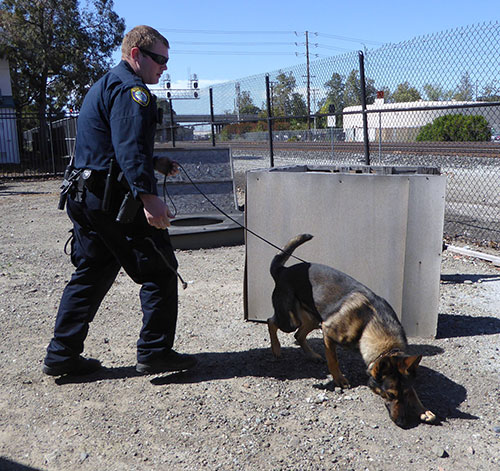

“Santa Clara police K9 unit! Come out now or a police dog will be sent to find you,” called out K9 handler Kevin Estes during a police investigation last February. Repeating the warning was enough to bring about the peaceful surrender of five people.
Had the suspects not come out, Officer Estes’s last warning would have been, “Since you have chosen not to comply, I can no longer ensure your safety. When the dog finds you, he will bite you. Come out!”
Though serious police investigation, it is all a game to Argo, Brek, Dex and Ranger, the four young Santa Clara Police Department (SCPD) K9s who sniff out local crime. They are deployed for violent felony and weapons-related crimes that pose a danger to the public and the police. The K9 unit also assists surrounding law enforcement agencies, such as the County Sheriff’s Department and Sunnyvale Police Department.
SCPD’s four male German shepherds–from the Czech and Slovak Republics and Romania–don’t know that they are highly-effective crime stoppers. They think they are playing a game. And what motivates them, is their expectation of getting a reward when they win–when they locate a stash of narcotics or explosives or track and locate a crime suspect.
The reward that gets them excited and wagging their tails is playing with a rubber ball dangling from the end of a length of rope or tugging on a jute-covered tug toy held by their handler.
“A good police dog must have a high ‘ball drive,'” said Officer Craig Shapiro, three-year-old Dex’s handler. “A strong desire for its ball motivates it to overcome its fears– of the dark or a slick floor, for example–and to keep searching for someone in a dark building at night.”
“They are motivated by play, and a game of tug of war with their handlers is the ultimate reward,” said Officer Tom Gratny, five-year-old Argo’s handler, adding, “We don’t put the dogs in a situation to fail. We do everything we can to allow them to succeed.”
Each dog is alerted that the game is about to begin when its special game collar, harness or bullet-proof vest is put on it. Commands are given in German, and, depending on the situation, the dog works either on or off leash. All four K9s are trained in apprehension tracking, building searches, and officer protection. One is trained to detect narcotics and three to detect explosives.
The handlers are sensitive to their dog’s body language when it alerts to finding something. A bark alert would be for human odor, and a head snap up or sitting would be a passive alert in finding narcotics or explosives. An aggressive alert such as pawing or jumping would be dangerous.
Their highly-developed sense of smell is what makes them effective. Gratny said that while he smells a pot of stew cooking, his dog smells the individual ingredients in the stew–the onions, seasonings.
A police dog can learn to detect as many as 20 individual odors, enabling it to sniff out cell phones or USB drives in jails and smell the oils on firearms. It can detect individual components of explosives when doing sweeps, such as for Super Bowl 50, when dignitaries like the Dalai Lama or president come to town or before shareholder meetings.
“When the dogs are working, they’re working hard,” said Shapiro. “It’s exhausting for the dog to breathe in and out on a search.” Their duties require physical agility to get into confined areas, walk on metal grating, or sweep fields, and about an hour is the longest a dog can be kept interested before it needs to rest.
Each city-owned police dog is paired exclusively with one handler, with whom it lives, trains and works, riding in a caged area of its handler’s patrol car.
“The dogs go home with us and interact with our families,” said Gratny. “They spend more time with us than our own children.”
The handlers put their dogs through daily obedience and searching drills. The dogs, however, don’t know the difference between training and the real thing. Once a month, all work together with a trained K9 handler, doing drills at, for example, Great America, Levi’s Stadium or Agnew’s Developmental Center.
The K9 unit, which began in 1988, is always looking for new training locations to keep drills realistic. Building owners willing to offer their empty building, day or night, as an occasional training site, can contact Training & K9 Unit Sergeant Kevin Fraser at the police department.
The SCPD K9s were purchased by the Sean M. Walsh K-9 Memorial Foundation, founded in memory of Army National Guard Specialist Sean M. Walsh, killed in Afghanistan in 2011. Two-year-old Brek, handled by Officer Jerry Ogg, is the unit’s newest dog, purchased thanks to a $10,000 Rotary Club of Santa Clara contribution to the foundation.
“We are grateful for the support of the community with our K9 unit. The assistance we have received, from the Sean Walsh K9 Memorial Foundation to the Police and Working K9 Foundation, is what helps us function,” wrote Fraser in an email.
“It’s a fantastic job within the police department, working around great people,” said Ogg.
“This is the greatest assignment in the police department,” said Gratny, the senior K9 handler.
Santa Clarans can meet Argo, Brek, Dex and two-year-old Ranger (officer Estes’s dog) at city events such as the Art and Wine Festival.





